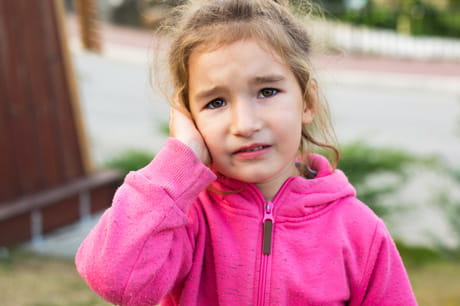You’re probably right.
“Ear infections are extremely common in children,” explains Geisinger Pediatric Ear, Nose and Throat specialist Aileen Wertz, MD. “They’re like any infection you get in your nose or throat. And we all know how common runny noses and coughs are in kids.”
Ear infection symptoms to look for
According to Dr. Wertz, if your child is tugging or pulling at their ears, is fussy or lethargic and refusing to eat and has a fever of 101 or higher, chances are they have an ear infection. And it’s a good idea to call your child’s pediatrician or primary care provider — especially if you’re seeing fluid draining from their ear.
“The drainage we look for with ear infections is very different from ear wax,” she explains. “It’s a clearer liquid, more like what you see with nasal discharge.”
The good news is, most ear infections are not serious, and many clear up within a few days on their own. “But if your child’s symptoms haven’t improved after three days, it’s time to call the doctor,” cautions Dr. Wertz.
Different types of ear infections
Some ear infections are caused by bacteria. Others are caused by a virus. If your child’s ear infection is caused by bacteria, they might need an antibiotic — which, depending on the infection’s location, could be given via drops in the ear or taken orally.
“Ear infections occur in different parts of the ear,” explains Dr. Wertz. “If the infection is in the ear canal, your child will probably be prescribed ear drops. These external ear infections are often caused by water in the ear from swimming. Infections in the middle ear, behind the eardrum, usually occur with colds or seasonal allergies. They’re a bit more serious, and it usually takes oral antibiotics to clear them up. Acetaminophen or ibuprofen can also be used to help with the pain.”
Could it be teething pain?
Since ear infections are most common in children ages 9 months to 2 years and the symptoms are similar, it’s sometimes hard to tell whether discomfort is caused by an infection or teething. But according to Dr. Wertz, there are signs to look for. “When young children are teething, there is pain and fussiness and sometimes a low-grade fever,” she explains. “But a fever of 101 or higher is a pretty good sign that you’re dealing with an ear infection, especially if they’re pulling at their ears, too.”
When to see an Ear, Nose and Throat (ENT) specialist
If you suspect your child has an ear infection, your first step is to call their pediatrician or primary care provider. If they do identify an infection, they’ll most likely prescribe antibiotics and the infection will usually clear up quickly. If your child doesn’t get better, is in severe pain, or suffers from repeated ear infections, you may be referred to a pediatric ENT specialist like Dr. Wertz — also known as an otolaryngologist.
“The most common treatment for chronic ear infections is to place a tube in the eardrum to provide ventilation to the middle ear and prevent fluid buildup,” says Dr. Wertz. “This very minor outpatient procedure usually resolves the issue right away.”
Dr. Wertz explains that in 95 percent of her patients, the ear tubes fall out once they are past the stage where ear infections are common, and she rarely has to perform a retubing procedure.
Another less common procedure she performs involves surgically removing adenoid tissue from back of the nose. “But that’s only in rare cases,” she says.
“If your child suffers from recurring or severe ear infections, it’s important that they see their pediatrician or primary care provider — who can refer them to an ENT specialist if necessary,” adds Dr. Wertz. “Most ear infections aren’t serious and are easy to treat, but left untreated, they can affect your child’s hearing and speech development. So, it’s definitely worth having them checked out.”
Next steps:
- Find out more about Pediatric ENT/otolaryngology
- Can meditation help your child? Read about integrative medicine for all ages
- Meet Aileen Wertz, MD


